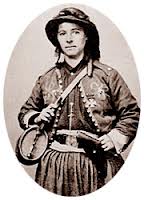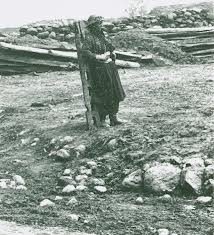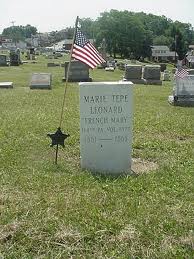 Pennsylvania Vivandière, Marie Brose Tepe, was a French Immigrant, whose Tenacity and bravery on the battlefield, was acknowledged by being, one of only two women, awarded the Kearney Cross for courage under fire. Tepe, also known as French Mary, served in at least 13 different battles of the Civil War, for a short time with 27th Pennsylvania Volunteers and won lasting acclaim with Collis and his Zouaves of the 114th Pennsylvania Infantry. Marie Tepe served in many roles on the line with her comrades, nurse or confidante and always carried in a shouldered cask, whiskey, water or wine, to quench the parched throat of a fellow trooper and a holstered .44 caliber revolver.
Pennsylvania Vivandière, Marie Brose Tepe, was a French Immigrant, whose Tenacity and bravery on the battlefield, was acknowledged by being, one of only two women, awarded the Kearney Cross for courage under fire. Tepe, also known as French Mary, served in at least 13 different battles of the Civil War, for a short time with 27th Pennsylvania Volunteers and won lasting acclaim with Collis and his Zouaves of the 114th Pennsylvania Infantry. Marie Tepe served in many roles on the line with her comrades, nurse or confidante and always carried in a shouldered cask, whiskey, water or wine, to quench the parched throat of a fellow trooper and a holstered .44 caliber revolver.
Marie Brose was born in Brest, France, in 1834. When Marie was 10, she immigrated to the United States and by the late 1850s, she had married Bernardo Tepe, a tailor, in Philadelphia, Pennsylvania. When the Civil War broke out, Bernhard enlisted in Company I, 27th Pennsylvania Volunteers. Despite urging Marie to stay home and tend to the tailor shop, the tenacious 27-year-old wife followed her husband to serve as a Vivandière.
Tepe, initially sold goods, that the Army didn’t offer, including whiskey, cigars and hams to the soldiers. When the regiment was not in action, Marie cooked, washed, and mended for the men. Before the end of 1861, Marie left her husband and the 27th Pennsylvania. A veteran is quoted as giving the following explanation,
“One night some soldiers, among whom was her husband, broke into the vivandiere’s tent and stole $1,600. The men were afterwards punished, but the vivandiere decided to quit the regiment. She refused to have anything to do with her husband. . . [She was] requested to continue with the regiment, but her indignation was so great that she left.”
Then in August of 1862, Marie Tepe joined Collis, when he raised nine more Pennsylvania companies to form the 114th, with himself as colonel. Like the original company, the 114th was a Zouave unit, based on the renowned North African European Zouave regiments of the French army. The soldiers wore a Zouave uniform and so did Marie. She wore a blue jacket and red pants; to distinguish herself from the men and a skirt trimmed in red.
Marie purchased a supply of goods not issued by the government and met her comrades material needs, in addition to her nursing, occasional sewing and laundering. French Mary drew the pay of a soldier and was allowed 25 cents per day extra for hospital and head quarters services, making her pay $21.45 per month. The Paymaster’s Department received a complaint regarding women’s pay and stopped Marie’s monthly payment. However, Tepe continued selling her goods to the soldiers and $5 per pint for whiskey, was not an unusual price.
On December 13, 1862, at the Battle of Fredericksburg, a veteran of the 114th Pennsylvania recalled,
“Here, with the surgeons and Marie, the vivandiere, we established the field hospital, and soon after we had quite a number of our regiment, who were wounded, to assist in taking care of.”
Marie was wounded during this battle and she would carry the ball in her ankle for the rest of her life. It has been related that Tepe received a silver cup presented to her by Lieutenant Colonel Cavada that was inscribed, “To Marie, for noble conduct on the field of battle.” She is also said to have received a letter on December 21, 1862, from Colonel Collis thanking her for her bravery at Fredericksburg.
On May 3, 1863, at the Battle of Chancellorsville, a female nurse from Maine wrote,
“[S]ince I left . . . for the hospital at Chancellorsville, I had not seen a woman, and I did not know that any other woman crossed the [Rappahannock] river at this place . . . excepting ‘Mary,’ the vivandiere of the 114th P.V., who was a brave and faithful worker.”
After this battle Marie received the “Kearny Cross” for helping to organize one of the field hospitals. A member of the 114th Pennsylvania related,
“We were pleased to find that quite a number of the valiant comrades of our regiment had received medals for meritorious conduct in battle, . . . Even Marie, the vivandiere, received one, but she would not wear it, remarking that General Birney could keep it, as she did not want the present. . . She was a courageous woman, and often got within range of the enemy’s fire whilst parting with the contents of her canteen among our wounded men. Her skirts were riddled by bullets during the battle of Chancellorsville.”
Marie Tepe cherished the Kearney Cross for the rest of her life and was proudly photographed wearing the medal.
 At Gettysburg, most of the Vivandières were sent home when the heavy fighting started, Marie Tepe was the only documented Vivandière at Gettysburg, where she carried water and treated the wounded during the fiercest of the fighting. After the battle, she served as a nurse in the field hospital behind the Round Tops.
At Gettysburg, most of the Vivandières were sent home when the heavy fighting started, Marie Tepe was the only documented Vivandière at Gettysburg, where she carried water and treated the wounded during the fiercest of the fighting. After the battle, she served as a nurse in the field hospital behind the Round Tops.
In the spring of 1864, Marie was still with the 114th Pennsylvania, at the Battle of Spotsylvania Court House and another veteran described Tepe thusly,
“I looked around and sure enough there was a woman! She was about 25 years of age, square featured and sunburnt, and dressed in Zouave uniform in the Vivandiere style. She was with two men and they seemed to be looking for their regiment, the 114th Pennsylvania Infantry.”
Some veterans state that Marie Tepe marched with the 114th Pennsylvania on May 23, 1865, at the Grand Review in Washington D.C. Marie mustered out with her comrades shortly after the final parade and celebration of the Civil War heroes.
Marie moved to the Pittsburgh, Pennsylvania and married Richard Leonard, a veteran of Company K, 1st Maryland Cavalry. Their date of marriage was April 9, 1872. In 1893 she travelled to Philadelphia to celebrate the anniversary of the Battle of Fredericksburg and a reunion of the 114th Pennsylvania. Marie wore her Kearney Cross and had her whiskey keg slung over her shoulder.
After filing for divorce in 1897, being in poor health Marie Tepe, took her own life, in May of 1901 and was laid to rest in an unmarked grave.
 In 1988, members of the Pittsburgh Camp No. 3 of the Sons of Union Veterans found Marie’s final resting place at St. Paul’s Cemetery on Lafferty Hill in Carrick, Pennsylvania, placed a military headstone and dedicated the grave in a proper military ceremony.
In 1988, members of the Pittsburgh Camp No. 3 of the Sons of Union Veterans found Marie’s final resting place at St. Paul’s Cemetery on Lafferty Hill in Carrick, Pennsylvania, placed a military headstone and dedicated the grave in a proper military ceremony.
Pennsylvania Vivandière, Marie Brose Tepe, a French Immigrant of Tenacity, proved that a woman could not only survive the nightmares of combat, but could also serve with valor and fortitude, while saving the lives of hundreds of her comrades.
Bummer


Nice article bummer.
Pat,
Thanks for the read and have a healthy and enjoyable summer.
Bummer
Wonderful information about a civil.war hero. Thank you for posting. I am a living historian and Marie Tepe is my persona. I continue to research her life.